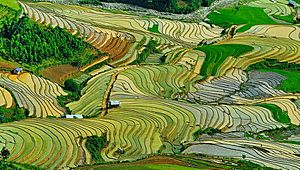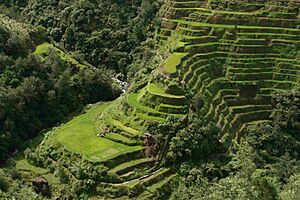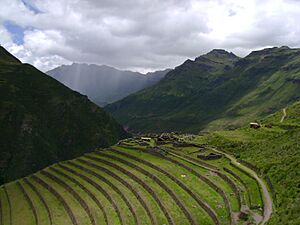Terrace farming facts for kids
Terrace farming is a special way of farming that has been used for thousands of years. It involves making flat, stepped areas called terraces on hillsides to grow crops.
Imagine trying to grow plants on a very steep hill. The soil would just wash away when it rains, right? That's where terrace farming helps! It's like building a giant staircase on a mountain. Each step is a flat area where farmers can plant food. This smart method lets people grow crops even in tough, hilly places.

Contents
When Did Terrace Farming Start?
Terrace farming began a very long time ago. People in the Andes Mountains of South America were using it as early as 3000 BC. That's about 5,000 years ago! In places like the Philippines and Vietnam in Southeast Asia, people also started building terraces around the same time, or even earlier. It's hard to know the exact start because early farmers didn't write down their history.
The Inca Empire (around 1438-1533 AD) used terrace farming a lot. The Incas were amazing builders. They made huge networks of terraces. This allowed them to grow many different crops, even high up in the Andes mountains. These terraces were more than just simple steps. They were designed to hold water and stop soil erosion.
The Incas used clever irrigation systems. These systems moved water to each terrace. This made sure their crops had enough water to grow well. The Incas were so good at terrace farming that their old systems can still be seen today. They show how skilled the Incas were at engineering.
In other parts of the world, different cultures also developed terrace farming. For example, in the rice fields of Southeast Asia, terrace farming has been key to growing food for centuries. The beautiful rice terraces in places like Banaue in the Philippines are great examples. They show how smart people can be and how they can work with nature.
How Does Terrace Farming Work?
Terrace farming is more than just making steps on a hill. It involves a lot of smart planning! Here's how it generally works:
Leveling the Land
The first step is to make each terrace flat. This creates a level surface for planting crops. Farmers often do this by hand. They use simple tools like shovels and hoes. For bigger projects, they might use more advanced tools or even machines.
Building Walls
To keep the soil from falling down, strong walls are built around the edges of each terrace. These walls can be made from different things. Farmers might use stone, earth, wood, or even concrete. They use what is easy to find nearby. The walls are built carefully to hold the soil and stop erosion.
Watering the Crops
Water is super important for growing plants. In terrace farming, special irrigation systems bring water to each terrace. This can be simple ditches or more complex systems with canals and pipes. The way the water system is built depends on the land and where the water comes from. Managing the water carefully is important to avoid too much or too little water.
Taking Care of the Soil
The soil on terraces needs good care. This helps stop erosion and keeps the soil healthy. Farmers often use methods like crop rotation. This means they grow different crops each season. They also use composting to make the soil better. This helps the soil stay productive for a long time.
Choosing the Right Crops
The types of crops grown on terraces depend on the weather, how high up the land is, and the soil. Farmers pick crops that grow well in their specific terrace environment. This could include rice, wheat, barley, potatoes, vegetables, or fruits. It all depends on the location and the time of year.
Benefits of Terrace Farming
Terrace farming has many great advantages:
- Less Soil Washing Away: The flat terraces stop the soil from being washed away by rain. This protects the valuable topsoil. This is very important in hilly areas where soil erosion can be a big problem.
- Better Water Use: Terraces help hold water. This makes sure crops have enough moisture to grow. This is helpful even when there isn't much rain.
- More Land for Growing: Terrace farming lets farmers use land that would otherwise be too steep for growing food. This increases the amount of land available for food production.
- More Kinds of Life: The different small environments on terraces can support more types of plants and animals. This helps make the area more diverse in nature.
- Looks Beautiful: Many terrace farms are stunning to look at. They create beautiful landscapes that tourists often visit. The detailed patterns of the terraces show how clever people are and how they can live in harmony with nature.
Challenges of Terrace Farming
Even with all its benefits, terrace farming also has some difficulties:
- Needs Lots of Work: Building and taking care of terraces requires a lot of hard work. It's often done by hand. This can take a lot of time and be physically tiring.
- Costs a Lot to Start: Building terraces can be expensive at first. It needs a lot of money for workers and materials.
- Needs Ongoing Care: Terraces need constant care to prevent erosion. They also need to make sure water is managed correctly. This means farmers have to work hard all the time.
- Can Be Damaged by Disasters: Terraces can be harmed by natural events. Things like floods, landslides, or earthquakes can cause damage. This can lead to big losses for farmers.
Images for kids
-
Terraced fields in Sa Pa, Vietnam.
-
Terraced fields in the Upper Mustang region of Nepal
-
Terraced field in Kabal Swat valley, Pakistan.
-
Rice terrace in Bali
-
Jatiluwih rice terrace in Bali, Indonesia.
-
Rice cultivation, Lower Himalayas, Nepal.
-
Longsheng Rice Terrace in Longsheng county, Guangxi Province, southern China.
-
Lynchet system near Bishopstone in Wiltshire
-
Terrace vineyard in the coteaux du Layon on the commune of Faye-d’Anjou, Maine-et-Loire, France
-
rice cultivation in West Bengal, India.
See also
 In Spanish: Bancal para niños
In Spanish: Bancal para niños






















